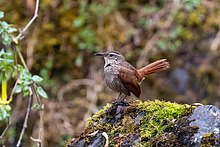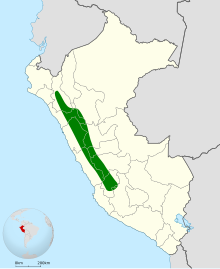| Striated earthcreeper | |
|---|---|

| |
| Conservation status | |
 Least Concern (IUCN 3.1) | |
| Scientific classification | |
| Domain: | Eukaryota |
| Kingdom: | Animalia |
| Phylum: | Chordata |
| Class: | Aves |
| Order: | Passeriformes |
| Family: | Furnariidae |
| Genus: | Geocerthia Chesser, RT, & Claramunt, 2009 |
| Species: | G. serrana |
| Binomial name | |
| Geocerthia serrana (Taczanowski, 1875) | |

| |
| Synonyms | |
|
Upucerthia serrana | |
The striated earthcreeper (Geocerthia serrana) is a species of bird in the Furnariinae subfamily of the ovenbird family Furnariidae. It is endemic to Peru.
Taxonomy and systematics
The striated earthcreeper was long placed in genus Upucerthia with several other earthcreepers. Genetic studies in the early 2000s refuted that placement and genus Geocerthia was created for it.
The striated earthcreeper has two subspecies, the nominate G. s. serrana (Taczanowski, 1875) and G. s. huancavelicae (Morrison, ARG, 1938).
Description
The striated earchcreeper is 18 to 20.5 cm (7.1 to 8.1 in) long and weighs 41 to 52 g (1.4 to 1.8 oz). It is a large earthcreeper with long slightly decurved bill. The sexes' plumages are alike. Adults of the nominate subspecies have a whitish buff supercilium. Their crown is dusky brown with narrow whitish buff streaks on the forehead. The sides of their neck and their back are dark brown; the neck has thin whitish buff streaks. Their rump is dark rufous brown. Their tail is dull rufous; sometimes the central pair of feathers are browner. Their wings are rufous. Their throat is dirty white with some dusky scaling and their breast and belly dull gray brown or olive brown with whitish buff streaks. Their iris is any of several dark shades of brown, their bill black or horn, and their legs and feet gray or brown. Juveniles have a scaled appearance on their breast and faint bars on their upper belly. Subspecies G. s. huancavelicae has much darker upperparts than the nominate, and darker and grayer underparts with little warm brown.
Distribution and habitat
The nominate subspecies of the striated earthcreeper is found in the Andes of northern and central Peru from the Department of Cajamarca south to the departments of Lima and Junín. Subspecies G. s. huancavelicae is found only in the southern Peruvian Andes of the Department of Huancavelica.
The striated earthcreeper inhabits areas of denser woody vegetation than most other earthcreepers. It mostly occurs in arid montane scrublands, on rocky slopes with bushes, and in Polylepis woodlands. In elevation it mostly ranges between 3,000 and 4,600 m (9,800 and 15,100 ft) but occurs locally below that.
Behavior
Movement
The striated earthcreeper is a year-round resident throughout its range.
Feeding
Little is known about the striated earthcreeper's diet though arthropods appear to be its major component. It typically forages singly or in pairs. It does most of its foraging on the ground by probing, gleaning, and flicking aside leaf litter. In Polylepis woodlands it also probes bark crevices for prey.
Breeding
Little is known about the striated earthcreeper's breeding biology. Its breeding season appears to span at least October to January. Only one nest has been described; it was in a burrow in a pebbly earth bank. The species has also nested in adobe walls.
|
Songs and calls Listen to striated earthcreeper on xeno-canto |
Vocalization
One publication described the striated earthcreeper's song as "a harsh slowing trill introduced by 3 notes, the 1st longest, keep kip kip trrrrrrrrr-r-r r, lasting c. 4 s" and its call as "a single, drawn-out, somewhat wheezy weeeee". Another describes the song as "a dry accelerating-decelerating trill: tp tp tp trr'r'r'r'r'r'e'e'e'e'e'r'r" and the call as "a scratchy djer-djer-djer-djer-djree".
Status
The IUCN has assessed the striated earthcreeper as being of Least Concern. It has a large range, and though its population size is not known it is believed to be stable. No immediate threats have been identified. "Human activity has little direct effect on the Striated Earthcreeper, other than the local effects of habitat destruction, such as from overgrazing."
References
- ^ BirdLife International (2018). "Striated Earthcreeper Geocerthia serrana". IUCN Red List of Threatened Species. 2018: e.T22702054A130272551. doi:10.2305/IUCN.UK.2018-2.RLTS.T22702054A130272551.en. Retrieved 24 August 2023.
- Gill, Frank; Donsker, David; Rasmussen, Pamela, eds. (July 2023). "Ovenbirds, woodcreepers". IOC World Bird List. v 13.2. Retrieved July 31, 2023.
- Chesser, R. T., S. C. Claramunt, E. Derryberry, & R. T. Brumfield (2009). Geocerthia, a new genus of terrestrial ovenbird (Aves: Passeriformes: Furnariidae). Zootaxa 2213: 64-68.
- Fjeldså, J., M. Irestedt, K.A. Jonsson, J.I. Ohlson, and P.G.P. Ericson. 2007. Phylogeny of the ovenbird genus Upucerthia: a case of independent adaptations for terrestrial life. Zoologica Scripta 36: 133–141.
- ^ Schulenberg, T. S. and T. Johnson (2020). Striated Earthcreeper (Geocerthia serrana), version 1.0. In Birds of the World (T. S. Schulenberg, Editor). Cornell Lab of Ornithology, Ithaca, NY, USA. https://doi.org/10.2173/bow.strear1.01 retrieved August 24, 2023
- ^ Fjeldså, J., and N. Krabbe (1990). Birds of the High Andes: A Manual to the Birds of the Temperate Zone of the Andes and Patagonia, South America. Zoological Museum, University of Copenhagen and Apollo Books, Copenhagen and Svendborg, Denmark.
- Vuilleumier, F. (1980). Notes. Pp. 333-342 in: Vaurie, C. (1980). Taxonomy and Geographical Distribution of the Furnariidae (Aves, Passeriformes). Bulletin of the American Museum of Natural History 166(1), New York.
- Schulenberg, T. S., D. F. Stotz, D. F. Lane, J. P. O’Neill, and T. A. Parker III. 2007. Birds of Peru. Princeton University Press, Princeton, New Jersey.
| Taxon identifiers | |
|---|---|
| Geocerthia serrana | |

